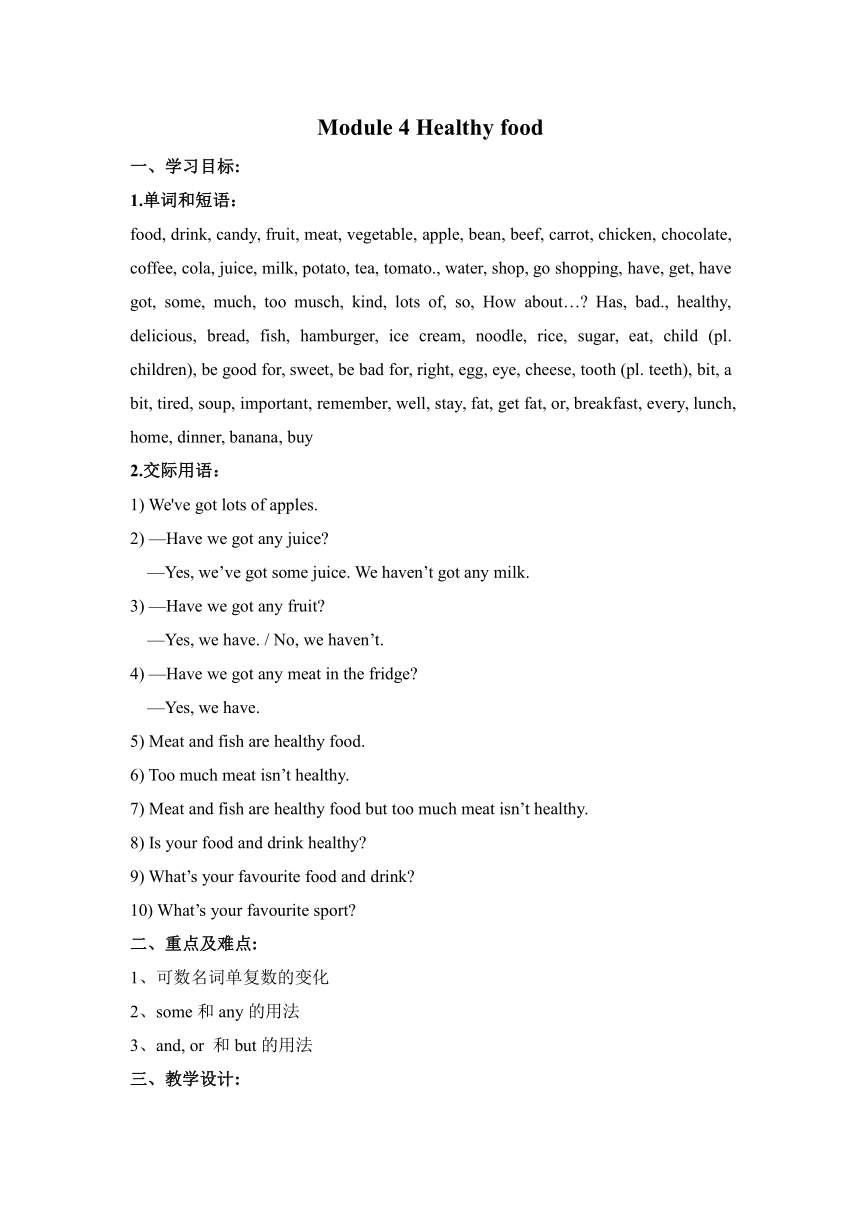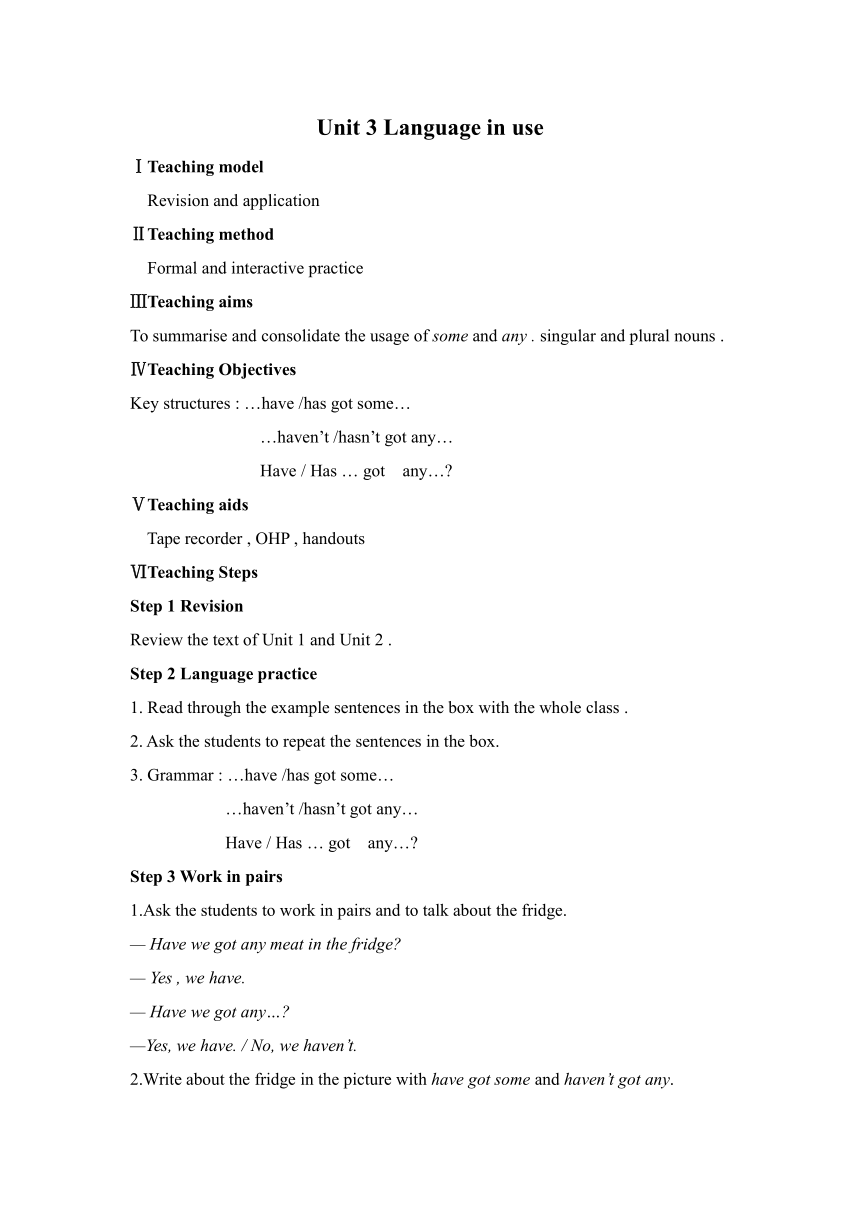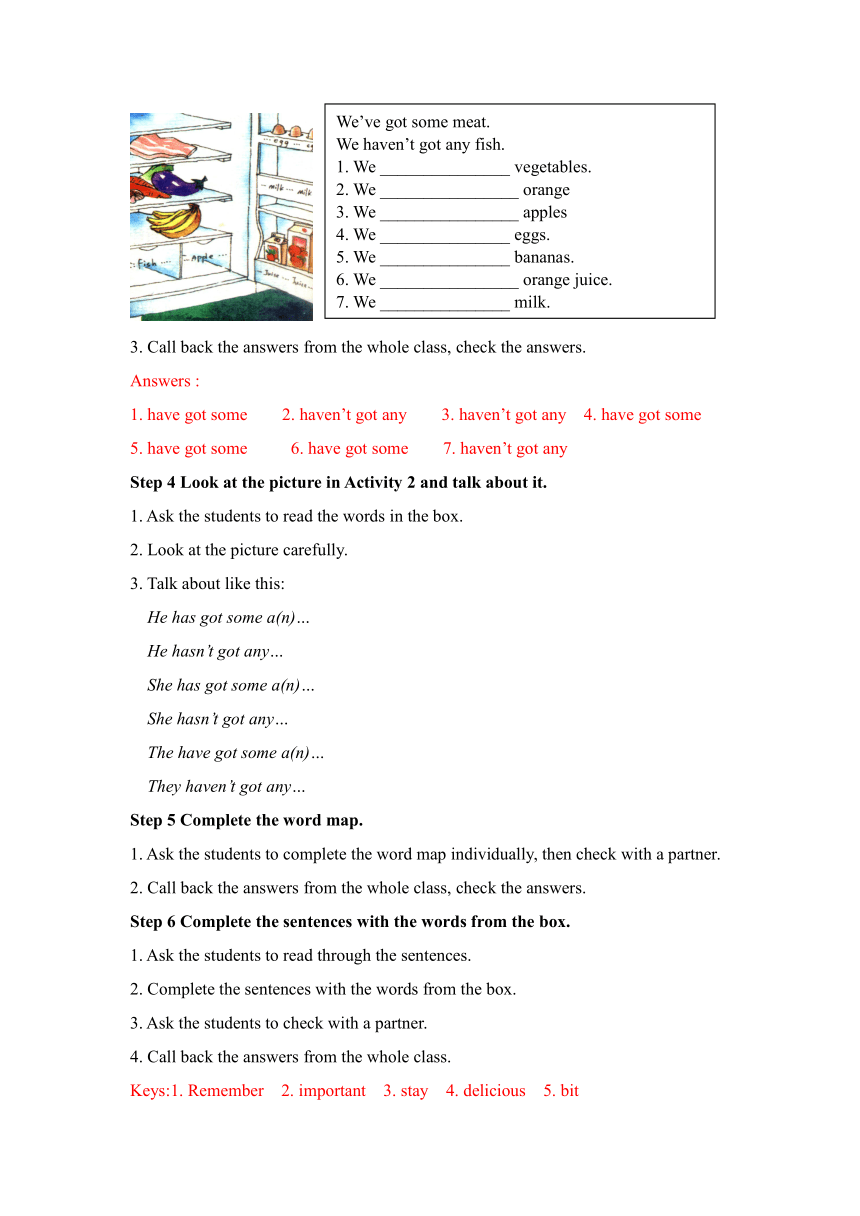七年级上>Module 4 Healthy food>Unit 3 Language in use
文档属性
| 名称 | 七年级上>Module 4 Healthy food>Unit 3 Language in use |  | |
| 格式 | zip | ||
| 文件大小 | 663.2KB | ||
| 资源类型 | 教案 | ||
| 版本资源 | 外研版 | ||
| 科目 | 英语 | ||
| 更新时间 | 2014-04-07 14:00:18 | ||
图片预览



文档简介
Module 4 Healthy food
一、学习目标:
1.单词和短语:
food, drink, candy, fruit, meat, vegetable, apple, bean, beef, carrot, chicken, chocolate, coffee, cola, juice, milk, potato, tea, tomato., water, shop, go shopping, have, get, have got, some, much, too musch, kind, lots of, so, How about… Has, bad., healthy, delicious, bread, fish, hamburger, ice cream, noodle, rice, sugar, eat, child (pl. children), be good for, sweet, be bad for, right, egg, eye, cheese, tooth (pl. teeth), bit, a bit, tired, soup, important, remember, well, stay, fat, get fat, or, breakfast, every, lunch, home, dinner, banana, buy
2.交际用语:
1) We've got lots of apples.
2) —Have we got any juice
—Yes, we’ve got some juice. We haven’t got any milk.
3) —Have we got any fruit
—Yes, we have. / No, we haven’t.
4) —Have we got any meat in the fridge
—Yes, we have.
5) Meat and fish are healthy food.
6) Too much meat isn’t healthy.
7) Meat and fish are healthy food but too much meat isn’t healthy.
8) Is your food and drink healthy
9) What’s your favourite food and drink
10) What’s your favourite sport
二、重点及难点:
1、可数名词单复数的变化
2、some和any的用法
3、and, or 和but的用法
三、教学设计:
Unit 3 Language in use
ⅠTeaching model
Revision and application
ⅡTeaching method
Formal and interactive practice
ⅢTeaching aims
To summarise and consolidate the usage of some and any . singular and plural nouns .
ⅣTeaching Objectives
Key structures : …have /has got some…
…haven’t /hasn’t got any…
Have / Has … got any…
ⅤTeaching aids
Tape recorder , OHP , handouts
ⅥTeaching Steps
Step 1 Revision
Review the text of Unit 1 and Unit 2 .
Step 2 Language practice
1. Read through the example sentences in the box with the whole class .
2. Ask the students to repeat the sentences in the box.
3. Grammar : …have /has got some…
…haven’t /hasn’t got any…
Have / Has … got any…
Step 3 Work in pairs
1.Ask the students to work in pairs and to talk about the fridge.
— Have we got any meat in the fridge
— Yes , we have.
— Have we got any…
—Yes, we have. / No, we haven’t.
2.Write about the fridge in the picture with have got some and haven’t got any.
3. Call back the answers from the whole class, check the answers.
Answers :
1. have got some 2. haven’t got any 3. haven’t got any 4. have got some
5. have got some 6. have got some 7. haven’t got any
Step 4 Look at the picture in Activity 2 and talk about it.
1. Ask the students to read the words in the box.
2. Look at the picture carefully.
3. Talk about like this:
He has got some a(n)…
He hasn’t got any…
She has got some a(n)…
She hasn’t got any…
The have got some a(n)…
They haven’t got any…
Step 5 Complete the word map.
1. Ask the students to complete the word map individually, then check with a partner.
2. Call back the answers from the whole class, check the answers.
Step 6 Complete the sentences with the words from the box.
1. Ask the students to read through the sentences.
2. Complete the sentences with the words from the box.
3. Ask the students to check with a partner.
4. Call back the answers from the whole class.
Keys:1. Remember 2. important 3. stay 4. delicious 5. bit
Step 7 Grammar.
名词的复数
A) 构成方法及读音规则
1) 一般情况加 –s:map-maps boy-boys girl-girls pen-pens bag-bags car-cars
清辅音后读/s/ 浊辅音和元音后读 /z/
2) 以s, sh, ch, x等结尾加 –es, 读 /iz/
bus-buses watch-watches box-boxes brush-brushes
3) 以辅音字母+y结尾,变y 为i再加es, 读 /z/
baby---babies city-cities country-countries
但以y结尾的专有名词,或元音字母+y 结尾的名词变复数时,直接加s变复数。例如:
two Marys the Henrys monkey---monkeys holiday---holidays
4) 以o结尾的名词,变复数时:
a. 加s,如: photo— photos piano—pianos
radio—radios zoo—zoos;
b. 加es,如:potato— potatoes tomato—tomatoes
5)以f或fe 结尾的名词变复数时:改f, fe 加ves,如:half—halves
knife—knives leaf—leaves wolf—wolves
wife—wives life—lives thief—thieves;
B) 名词复数的不规则变化
1) child—children , foot—feet , tooth—teeth mouse—mice , man—-men , woman—women
注意:由一个词加 man 或 woman构成的合成词,其复数形式也是 -men 和-women,如an Englishman,two Englishmen。但German不是合成词,故复数形式为Germans;Bowman是姓,其复数是the Bowmans。
2)单复同形,如deer,sheep,fish,Chinese,Japanese ,li,jin,yuan,two li,three mu,four jin等。但除人民币的元、角、分外,美元、英镑、法郎等都有复数形式。如:a dollar, two dollars; a meter, two meters。
3)集体名词,以单数形式出现,但实为复数。例如:
people police cattle 等本身就是复数,不能说 a people,a police,a cattle,但可以说a person,a policeman,a head of cattle.
4)以s结尾,仍为单数的名词,如:
a. maths,politics,physics等学科名词,一般是不可数名词,为单数。
b. news 为不可数名词。
c. the United States,the United Nations 应视为单数。
The United Nations was organized in 1945. 联合国是1945年组建起来的。
5) 表示由两部分构成的东西,如:glasses (眼镜) trousers, clothes等,若表达具体数目,要借助数量词 pair(对,双); suit(套); a pair of glasses; two pairs of trousers等。
6) 另外还有一些名词,其复数形式有时可表示特别意思,如:goods货物,waters水域,fishes(各种)鱼。
C) 不可数名词:不可数名词主要分物质名词和抽象名词。
1) 物质名词是指表示无法分为个体的实物的词,常见的物质名词,如:snow(雪),rain(雨), water(水),coffee(咖啡), tea(茶), meat (肉), milk(牛奶), rice(米饭), bread(面包), orange (桔汁), beef (牛肉), chicken(鸡肉) , juice (果汁), pork(猪肉) , Coke (可口可乐), ice cream (冰激凌) 等;
2) 抽象名词是指表示动作、状态、品质、感情等抽象概念的词,常见的抽象名词,如:work(工作), study(学习), love(爱), friendship (友谊)等。
Step 8 Around the world : A Western breakfast.
1. Ask the students to look at the picture and discuss what they can see.
2. Read through the information with the whole class.
Step 9 Module task: Making a poster about a healthy breakfast.
1.Work in groups of four or five. Make a poster about a healthy breakfast.
2. Present your poster to the class. Talk about it with your classmates.
Step 10 Exercise
A. 用 some, any填空。
1. —Have you got _______ fruit —Yes, we have.
2. —Have we got _______ meat —No, we haven’t.
3. We’ve got ________ oranges and _______ apples.
4. We have got _______ melons.
5. We haven’t got _______ tomatoes.
Answers:
1. any 2. any 3. some, some 4. some 5. any
B. 完成句子:
1. 我们有一些猪肉吗? 没有。
_________ we ___________________________
No , ___________________.
2. 你们有一些土豆吗? 有。
_________ you___________________________
Yes, ___________________.
3. 我们的冰箱里没有胡萝卜。
We __________________________ in the fridge.
4. 鱼和蔬菜是健康的食品,但汉堡包不是。
Fish and vegetables ___________________________ healthy food.
5. 吃些水果,不要吃糖果和冰激淋。
__________ some fruit , ____________ candy __________ ice cream .
Answers:
1. Have, got any pork , we haven’t 2. Have, got any potatoes, we have
3. haven’t got any carrots 4. are healthy food , but hamburgers aren’t
5. Eat, not , or
C. 根据短文内容及首字母提示,在空格处填入正确的词,使短文意思完整。
My name is Tom. I’m from (1)A _________ I’m fourteen (2)y _________ old . I’m in China with my (3)p _________ now. I like China. I like (4)C_________ food, too. I eat rice and (5)v _________ everyday. They are (6)h _________ food. My favourite vegetables are carrots and (7)t_________. I like drinking tea. My father and mother also like (8)d _________ tea, too. I don’t like Coke. Coke is (9)u _________ drink. I also eat noodles, fish and meat. I don’t like candy. Candy isn’t healthy food. I like fruit . Apples are my favourite (10)f _________
Keys :
1. America 2. years 3. parents 4. Chinese 5. vegetables
6. healthy 7. tomatoes 8. drinking 9. unhealthy 10. fruit
We’ve got some meat.
We haven’t got any fish.
1. We _______________ vegetables.
2. We ________________ orange
3. We ________________ apples
4. We _______________ eggs.
5. We _______________ bananas.
6. We ________________ orange juice.
7. We _______________ milk.
一、学习目标:
1.单词和短语:
food, drink, candy, fruit, meat, vegetable, apple, bean, beef, carrot, chicken, chocolate, coffee, cola, juice, milk, potato, tea, tomato., water, shop, go shopping, have, get, have got, some, much, too musch, kind, lots of, so, How about… Has, bad., healthy, delicious, bread, fish, hamburger, ice cream, noodle, rice, sugar, eat, child (pl. children), be good for, sweet, be bad for, right, egg, eye, cheese, tooth (pl. teeth), bit, a bit, tired, soup, important, remember, well, stay, fat, get fat, or, breakfast, every, lunch, home, dinner, banana, buy
2.交际用语:
1) We've got lots of apples.
2) —Have we got any juice
—Yes, we’ve got some juice. We haven’t got any milk.
3) —Have we got any fruit
—Yes, we have. / No, we haven’t.
4) —Have we got any meat in the fridge
—Yes, we have.
5) Meat and fish are healthy food.
6) Too much meat isn’t healthy.
7) Meat and fish are healthy food but too much meat isn’t healthy.
8) Is your food and drink healthy
9) What’s your favourite food and drink
10) What’s your favourite sport
二、重点及难点:
1、可数名词单复数的变化
2、some和any的用法
3、and, or 和but的用法
三、教学设计:
Unit 3 Language in use
ⅠTeaching model
Revision and application
ⅡTeaching method
Formal and interactive practice
ⅢTeaching aims
To summarise and consolidate the usage of some and any . singular and plural nouns .
ⅣTeaching Objectives
Key structures : …have /has got some…
…haven’t /hasn’t got any…
Have / Has … got any…
ⅤTeaching aids
Tape recorder , OHP , handouts
ⅥTeaching Steps
Step 1 Revision
Review the text of Unit 1 and Unit 2 .
Step 2 Language practice
1. Read through the example sentences in the box with the whole class .
2. Ask the students to repeat the sentences in the box.
3. Grammar : …have /has got some…
…haven’t /hasn’t got any…
Have / Has … got any…
Step 3 Work in pairs
1.Ask the students to work in pairs and to talk about the fridge.
— Have we got any meat in the fridge
— Yes , we have.
— Have we got any…
—Yes, we have. / No, we haven’t.
2.Write about the fridge in the picture with have got some and haven’t got any.
3. Call back the answers from the whole class, check the answers.
Answers :
1. have got some 2. haven’t got any 3. haven’t got any 4. have got some
5. have got some 6. have got some 7. haven’t got any
Step 4 Look at the picture in Activity 2 and talk about it.
1. Ask the students to read the words in the box.
2. Look at the picture carefully.
3. Talk about like this:
He has got some a(n)…
He hasn’t got any…
She has got some a(n)…
She hasn’t got any…
The have got some a(n)…
They haven’t got any…
Step 5 Complete the word map.
1. Ask the students to complete the word map individually, then check with a partner.
2. Call back the answers from the whole class, check the answers.
Step 6 Complete the sentences with the words from the box.
1. Ask the students to read through the sentences.
2. Complete the sentences with the words from the box.
3. Ask the students to check with a partner.
4. Call back the answers from the whole class.
Keys:1. Remember 2. important 3. stay 4. delicious 5. bit
Step 7 Grammar.
名词的复数
A) 构成方法及读音规则
1) 一般情况加 –s:map-maps boy-boys girl-girls pen-pens bag-bags car-cars
清辅音后读/s/ 浊辅音和元音后读 /z/
2) 以s, sh, ch, x等结尾加 –es, 读 /iz/
bus-buses watch-watches box-boxes brush-brushes
3) 以辅音字母+y结尾,变y 为i再加es, 读 /z/
baby---babies city-cities country-countries
但以y结尾的专有名词,或元音字母+y 结尾的名词变复数时,直接加s变复数。例如:
two Marys the Henrys monkey---monkeys holiday---holidays
4) 以o结尾的名词,变复数时:
a. 加s,如: photo— photos piano—pianos
radio—radios zoo—zoos;
b. 加es,如:potato— potatoes tomato—tomatoes
5)以f或fe 结尾的名词变复数时:改f, fe 加ves,如:half—halves
knife—knives leaf—leaves wolf—wolves
wife—wives life—lives thief—thieves;
B) 名词复数的不规则变化
1) child—children , foot—feet , tooth—teeth mouse—mice , man—-men , woman—women
注意:由一个词加 man 或 woman构成的合成词,其复数形式也是 -men 和-women,如an Englishman,two Englishmen。但German不是合成词,故复数形式为Germans;Bowman是姓,其复数是the Bowmans。
2)单复同形,如deer,sheep,fish,Chinese,Japanese ,li,jin,yuan,two li,three mu,four jin等。但除人民币的元、角、分外,美元、英镑、法郎等都有复数形式。如:a dollar, two dollars; a meter, two meters。
3)集体名词,以单数形式出现,但实为复数。例如:
people police cattle 等本身就是复数,不能说 a people,a police,a cattle,但可以说a person,a policeman,a head of cattle.
4)以s结尾,仍为单数的名词,如:
a. maths,politics,physics等学科名词,一般是不可数名词,为单数。
b. news 为不可数名词。
c. the United States,the United Nations 应视为单数。
The United Nations was organized in 1945. 联合国是1945年组建起来的。
5) 表示由两部分构成的东西,如:glasses (眼镜) trousers, clothes等,若表达具体数目,要借助数量词 pair(对,双); suit(套); a pair of glasses; two pairs of trousers等。
6) 另外还有一些名词,其复数形式有时可表示特别意思,如:goods货物,waters水域,fishes(各种)鱼。
C) 不可数名词:不可数名词主要分物质名词和抽象名词。
1) 物质名词是指表示无法分为个体的实物的词,常见的物质名词,如:snow(雪),rain(雨), water(水),coffee(咖啡), tea(茶), meat (肉), milk(牛奶), rice(米饭), bread(面包), orange (桔汁), beef (牛肉), chicken(鸡肉) , juice (果汁), pork(猪肉) , Coke (可口可乐), ice cream (冰激凌) 等;
2) 抽象名词是指表示动作、状态、品质、感情等抽象概念的词,常见的抽象名词,如:work(工作), study(学习), love(爱), friendship (友谊)等。
Step 8 Around the world : A Western breakfast.
1. Ask the students to look at the picture and discuss what they can see.
2. Read through the information with the whole class.
Step 9 Module task: Making a poster about a healthy breakfast.
1.Work in groups of four or five. Make a poster about a healthy breakfast.
2. Present your poster to the class. Talk about it with your classmates.
Step 10 Exercise
A. 用 some, any填空。
1. —Have you got _______ fruit —Yes, we have.
2. —Have we got _______ meat —No, we haven’t.
3. We’ve got ________ oranges and _______ apples.
4. We have got _______ melons.
5. We haven’t got _______ tomatoes.
Answers:
1. any 2. any 3. some, some 4. some 5. any
B. 完成句子:
1. 我们有一些猪肉吗? 没有。
_________ we ___________________________
No , ___________________.
2. 你们有一些土豆吗? 有。
_________ you___________________________
Yes, ___________________.
3. 我们的冰箱里没有胡萝卜。
We __________________________ in the fridge.
4. 鱼和蔬菜是健康的食品,但汉堡包不是。
Fish and vegetables ___________________________ healthy food.
5. 吃些水果,不要吃糖果和冰激淋。
__________ some fruit , ____________ candy __________ ice cream .
Answers:
1. Have, got any pork , we haven’t 2. Have, got any potatoes, we have
3. haven’t got any carrots 4. are healthy food , but hamburgers aren’t
5. Eat, not , or
C. 根据短文内容及首字母提示,在空格处填入正确的词,使短文意思完整。
My name is Tom. I’m from (1)A _________ I’m fourteen (2)y _________ old . I’m in China with my (3)p _________ now. I like China. I like (4)C_________ food, too. I eat rice and (5)v _________ everyday. They are (6)h _________ food. My favourite vegetables are carrots and (7)t_________. I like drinking tea. My father and mother also like (8)d _________ tea, too. I don’t like Coke. Coke is (9)u _________ drink. I also eat noodles, fish and meat. I don’t like candy. Candy isn’t healthy food. I like fruit . Apples are my favourite (10)f _________
Keys :
1. America 2. years 3. parents 4. Chinese 5. vegetables
6. healthy 7. tomatoes 8. drinking 9. unhealthy 10. fruit
We’ve got some meat.
We haven’t got any fish.
1. We _______________ vegetables.
2. We ________________ orange
3. We ________________ apples
4. We _______________ eggs.
5. We _______________ bananas.
6. We ________________ orange juice.
7. We _______________ milk.
同课章节目录
- Starte
- Module 1 My teacher and my friends
- Module 2 My English lesson
- Module 3 My English book
- Module 4 My everyday life
- Module 1 My classmates
- Unit 1 Nice to meet you.
- Unit 2 I'm Wang Lingling and I'm thirteen years ol
- Unit 3 Language in use.
- Module 2 My family
- Unit 1 Is this your mum?
- Unit 2 These are my parents.
- Unit 3 Language in use.
- Module 3 My school
- Unit 1 There are thirty students in my class.
- Unit 2 The library is on the left of the playgroun
- Unit 3 Language in use.
- Module 4 Healthy food
- Unit 1 We've got lots of apples.
- Unit 2 Is your food and drink healthy?
- Unit 3 Language in use.
- Module 5 My school day
- Unit 1 I love history.
- Unit 2 We start work at nine o'clock.
- Unit 3 Language in use.
- Revision module A
- Module 6 A trip to the zoo
- Unit 1 Does it eat meat?
- Unit 2 The tiger lives in Asia.
- Unit 3 Language in use.
- Module 7 Computers
- Unit 1 How do I write my homework on the computer?
- Unit 2 When do you use a computer?
- Unit 3 Language in use.
- Module 8 Choosing presents
- Unit 1 I always like birthday parties.
- Unit 2 She often goes to concerts.
- Unit 3 Language in use.
- Module 9 People and places
- Unit 1 We're enjoying the school trip a lot.
- Unit 2 They're waiting for buses or trains.
- Unit 3 Language in use.
- Module 10 Spring Festival
- Unit 1 Are you getting ready for Spring Festival?
- Unit 2 My mother's cleaning our houses and sweepin
- Unit 3 Language in use.
- Revision module B
